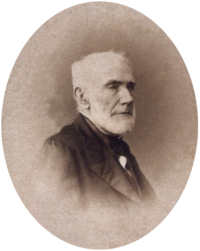Pedro de Araújo Lima, Marquis of Olinda
| The Marquis of Olinda | |
|---|---|

Pedro de Araújo Lima, Marquis of Olinda around age 67, c.1860
|
|
| Regent of the Empire of Brazil | |
|
In office 19 September 1837 – 23 July 1840 |
|
| Monarch | Pedro II |
| Preceded by | Diogo Antônio Feijó |
| Succeeded by | None (Emperor Pedro II declared of age) otherwise, Princess Isabel (in 1871, while Emperor Pedro II traveled abroad) |
| President of the Council of Ministers | |
|
In office 29 September 1848 – 8 October 1849 |
|
| Monarch | Pedro II |
| Preceded by | Sousa e Melo |
| Succeeded by | Marquis of Monte Alegre |
|
In office 4 May 1857 – 12 December 1858 |
|
| Monarch | Pedro II |
| Preceded by | Duke of Caxias |
| Succeeded by | Viscount of Abaeté |
|
In office 30 May 1862 – 15 January 1864 |
|
| Monarch | Pedro II |
| Preceded by | Zacarias de Góis |
| Succeeded by | Zacarias de Góis |
|
In office 12 May 1865 – 3 August 1866 |
|
| Monarch | Pedro II |
| Preceded by | Francisco José Furtado |
| Succeeded by | Zacarias de Góis |
| Personal details | |
| Born |
22 December 1793 Antas farm, Pernambuco, Brazil (Portuguese Colony) |
| Died | 7 June 1870 (aged 76) Rio de Janeiro, Empire of Brazil |
| Occupation | Politician |
| Religion | Roman Catholic |
Pedro de Araújo Lima, Marquis of Olinda (22 December 1793 – 7 June 1870) was a politician and monarchist of the Empire of Brazil. His long political career expanded through the reigns of João VI, Pedro I and Pedro II. He was also one of the founders of the Brazilian Conservative Party.
He served as Regent of the Empire of Brazil from 1837 until 1840, during the minority of Emperor Pedro II. Later, during the personal reign of Pedro II, Olinda on four different periods served as President of the Council of Ministers.
Pedro de Araújo Lima was born on 22 December 1793. His birthplace was Antas farm, near the village of Sirinhaém in Pernambuco (a captaincy of the northeastern region of colonial Brazil). Through his father, Manuel de Araújo Lima, he was a descendant of settlers who had come from Portugal in the early 16th century with Duarte Coelho, the first captain general of Pernambuco. Through his mother, Ana Teixeira Cavalcante, his ancestry traced back to Filippo Cavalcanti, a nobleman from Florence. Filippo Cavalcanti married a daughter of the Portuguese settler Jerônimo de Albuquerque (a brother of Duarte Coelho's wife) and his Amerindian spouse (the daughter of a cacique, or chieftain, of the Tabajara people). His family was both old and wealthy. The family owned several engenhos ("engines"), as sugarcane plantations were called in Brazil. One of these properties was Antas farm. The sugarcane planters were the northeastern equivalent in power and wealth to later coffee farmers in Brazil's southeast.
...
Wikipedia
